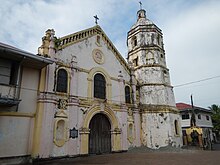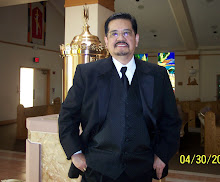 |
| Bus 5, Visita Iglesia 2015 of San Andres Apostol Parish |
On such Visita Iglesias, the faithful does the Via Crucis or the Stations of the Cross, praying at each of the 14 stations depicting Jesus Christ's suffering, and crucifixion. The object of the Stations is to help the faithful to make a spiritual pilgrimage of prayer, through meditating upon the chief scenes of Christ's sufferings and death
The province of choice for the Visita Iglesia 2015, Bataan, is the site of the historic Bataan Death March.
In barely less than a month, the Philippines will commemorate this historic event which took place some 63 years ago, on April 9, 1942 to be exact.
On this date, some 72,000 Filipino and American soldiers surrendered to the Japanese military, which brought to end the three-month Battle of Bataan that started on December 21, 1941. The Allied forces retreated to the Bataan Peninsula when the Japanese forces headed towards Manila after several deadly surprise air attacks that commenced in the bombing of Pearl Harbor in Hawaii in December 8th.
 |
| Bataan Death March |
The goal of the march was to get the 72,000 captured Filipino and American POWs from Mariveles in the southern end of the Bataan Peninsula to Camp O'Donnell in the north. To do this, the prisoners were to be marched 65 miles from Mariveles to San Fernando, then travel by train to Capas. From Capas, the prisoners were again to march for the last eight miles to Camp O'Donnell.
 The POWs were soon forced to make the 65 mile trek – with no food or
water – to the confinement camp in O'Donnell. Thirsty and
exhausted, those soldiers who attempted to steal a sip of water from roadside
streams or collapsed along the way – were shot or bayoneted on the spot
by their Japanese captors. In total, 10,000 men – 1,000 American and
9,000 Filipino – died during the Bataan Death March.
The POWs were soon forced to make the 65 mile trek – with no food or
water – to the confinement camp in O'Donnell. Thirsty and
exhausted, those soldiers who attempted to steal a sip of water from roadside
streams or collapsed along the way – were shot or bayoneted on the spot
by their Japanese captors. In total, 10,000 men – 1,000 American and
9,000 Filipino – died during the Bataan Death March.The Visita Iglesia 2015 became not just a religious exercise for me, but allowed me to dwell on the significance of the province of Bataan to the overall Philippine modern history.
 | ||||||||||||||||||||
| THE ROUTE OF THE BATAAN DEATH MARCH |
From the chronicles of www.batch2006.com/visit_bataan_death-march.htm:
"The Death March
started from two points in Bataan: on April 10 from Mariveles, on
April 11 from Bagac. The Filipino and American troops were marched
day and nighrt, under blistering sun or cold night sky, staggering
through Cabcaben, Limay, Oion, Pilar, and Balanga, where they were
given a brief rest and some water, From Balanga the Prisoners of
were organized into groups of 100 to 200 and under guard marched
on through were segregated from the Filipino Prisoners of war and
marched separately, The march continued northward through Hermosa
to Layac Junctio, then Eastward into Pampanga through Lubao,
Guagua, Where the Prisoners were rested and given a little food at
the National Development Company Compound.
Already suffering
from Battle fatigue, The Filipino and Americans troops were
strained to utter exhaustation by this long march on foot, many
were ill, most were feverish, but none high rest, for the enemy
was brutal with those who lagged behind. Thousands fell along the
way, Townspeople on the roadside risked their lives by slipping
food and drink to the Death Marches as they stumbled by.
In San Fernanco, The Death March became a death ride by
cargo train when the prisoners were pack so densely into boxcars
that many of them perished from suffocation, Those who arrived
alive in Capas had still to walk the last and most agonized miles
of the Death March: The 6 Kilometers to Camp O'Donnel,
Which was become one of the most hellish concentration camps of World
War II."
 |
| Death March Marker, Km. 65, Hermosa, Bataan |
 |
| Death March Marker, Km. 60, Orani, Bataan |
The San Andres Apostol Visita Iglesia 2015 took the reverse
route and passed through San Fernando, Lubao and Guagua in Pampanga and
proceeded to Hermosa, Bataan for its first pilgrim stop at the old
Church of St. Peter of Verona.
St. Peter of Verona in Hermosa, Bataan
The Parish of Saint Peter of Verona belongs to the Roman Catholic Diocese of Balanga. Its Feast day is May 3. It is untheder Vicariate of Saint Peter
Verona.
Historically, the town was established in 1756 by Dominican priests. It
became an independent missionary center in 1756 with St. Peter de Verona
as its patron saint.
The church features a baroque-style
façade with marvelous stained-glasses windows amid the splendor of the
ornaments inside the church which illuminates the whole of Hermosa.
The
major retablo
of Hermosa is made more attractive by the variations of saints placed
in it amid its majestic dome. The church brings remembrance of the
colonial past.
 |
| Our Lady of the Most Holy Rosary |
 |
| The Church of Our Lady of the Most Holy Rosary in Orani The Roman Catholic church of Orani was declared an independent parish on April 21, 1714, and also known as Our Lady of the Most Holy Rosary Parish Church ("Our Lady of the Rosary of Orani Church", "Nuestra Señora del Rosario Parish Church", "Simbahan ng Orani" or "Virgen Milagrosa Del Rosario del Pueblo de Orani Shrine"). It is a Neoclassical (heritage) Diocesan Marian Shrine and Pilgrimage church located in the center of Orani, Bataan in the Philippines. |
 |
| Museum within the church complex |
Our pilgrimage visited St. Catherine of Sienna, located in Samal, Bataan for our 5th and 6th Stations of the Cross.
 |
| St. Catherine of Siena in Samal |
The 1596 Parish Church of St. Catherine of Siena belongs to the Romn Catholic Diocese of Balanga.
(Dioecesis Balangensis - Suffragan of San Fernando, Pampanga Created:
March 17, 1975. Canonically Erected: November 7, 1975).
It has a Catholic population of 11,581 under the Titular of St.
Catherine of Siena whose Feast day falls on April 30.
In 1596, the Dominicans directed the spirituality of Samal. Attacked
by Dutch invaders in April 1647, the local garrison of Pampanga under
Alejo Aguas ousted the Dutch forces.
Rev. Jeromino Belen, O.P. rebuilt
the ruined church and the convent. In 1896 the Katipuneros burmed the
church and the convent which were rebuilt by Rev. Justo Quesada in 1903.
For the 7th and 8th Via Crucis, we went to the Bahay Puso Home for the Aged and on to the Cathedral of St. Joseph, both of these located in the capital city of Balanga.
Below right, one of the structures in the Bahay Puso property where abandoned elderly are being taken cared of.
At the height of the afternoon sun, our Visita Iglesia disembarked at the St. Joseph Cathedral, also known as Balanga Cathedral. St. Joseph Cathedral stands massively amid the town center of Balanga, itself a showcase of early 18th century architecture.
 |
| Balanga City Hall |
 |
| Town Plaza in Balanga |
 | |||||||||||
| St. Joseph Cathedralin Balanga |
 The Cathedral is the seat of the Diocese of Balanga which comprises the entire civil province of Bataan.
The Cathedral is the seat of the Diocese of Balanga which comprises the entire civil province of Bataan.  |
| Staircase leading to choir loft |
 |
| An angel as Holy Water and Confessional Box guardian |
There were other parishes also doing their own pilgrimage on the same day as our Parish that's why the roads leading to the churches were extra ordinarily jammed. We walked quite a distance to the churches themselves.
For the 11the and 12th Stations, we went next to the Church of Our Lady of Pillar which has a quaint archway leading to the main ground.
The 7th town and parish founded by the Dominican Fathers after Abucay (1588), Samal (1596), Orion (1667), Orani (1714), Balanga (1739) and Hermosa (1757), Pilar was made an independent vicariate on March 10, 1801. The Secular clergy replaced all regular Spanish religious missionaries including Bataan.
On April 10, 1801, Pilar was declared an independent municipality. Fr. Damaso Salvador Lintag, the first Filipino secular assigned in Pilar proclaimed Our Lady of the Pilar its Patroness, hence the town’s name Pilar.
The first chapel in the poblacion was made of wood and nipa roofing. In 1834, the Dominican priests built the stone church but local revolutionaries burned down the church, including the rectory on May 28, 1898 but the image of Nuestra Senora del Pilar survived.
A temporary church was built. Fr. Fermin de San Julian, the last Dominican priest in 1901 stayed as the parish priest until 1931, building a new stone church.
 | |||||||||||||||||||||||||||||||||||||||||||||||||||||||||||||||
| Our Lady of Pillar Church in Pilar |
 - - | |||||||||||||||||||||||||||||||||||||||||||||||||||||||||||||||||||||||||||||||||||||||||||||||||||||||||||||||||||||||||||
| St. Michael the Archangel Church in Orion |
Our Visita Iglesia would have ended as planned at the Dambana ng Kagitingan in Mt. Samat, Bataan, where the Fil-Am soldiers made their last stand against the Japanese forces. But due to delays caused by traffic and other circumstances, the trip to the Shrine was cancelled, and our Pilgrimage headed back to Manila.
 | ||
| The main altar at St. Michael the Archangel |
 |
| Dambana ng Kagitingan in Mt. Samat |























